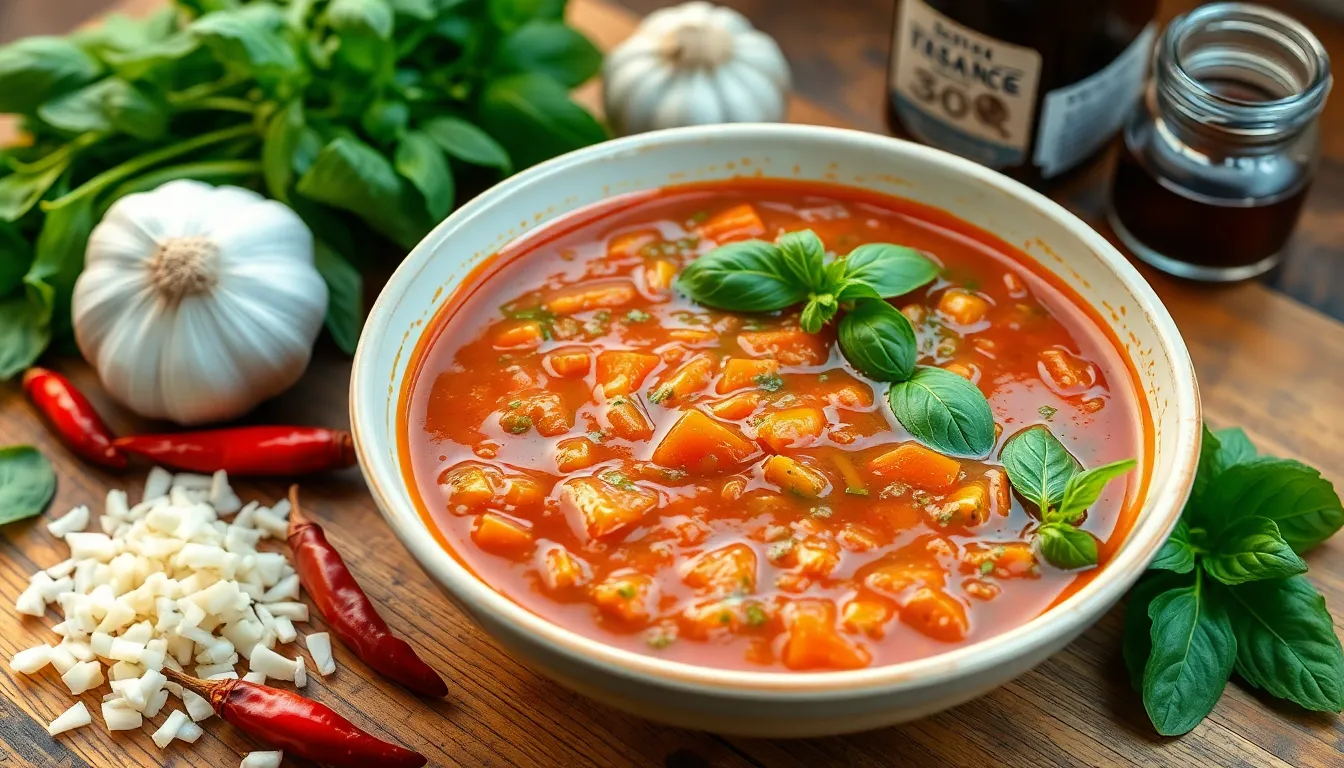Looking for a Thai basil sauce that’ll transform your everyday meals into exotic culinary adventures? This versatile condiment packs intense flavor with minimal effort—perfect for busy weeknights when you crave something special.
Thai basil sauce combines the aromatic punch of Thai basil with savory garlic, spicy chilies, and umami-rich fish sauce to create a harmony of authentic Thai flavors. You’ll love how this vibrant green sauce brings life to simple proteins, rice bowls, or noodle dishes. Unlike regular basil, Thai basil maintains its bold flavor even when cooked, making it perfect for hot applications.
Whether you’re drizzling it over grilled chicken, using it as a dipping sauce for spring rolls, or tossing it with vegetables, this 10-minute sauce will become your secret weapon for elevating meals with minimal effort. It stores beautifully in the refrigerator, developing even deeper flavors overnight.
What Makes Thai Basil Sauce Special
Thai basil sauce stands out in the industry of condiments thanks to its distinctive flavor profile and aromatic qualities. The sauce derives its character from several key elements that work together to create something truly exceptional.
The Power of Thai Basil
Thai basil differs dramatically from its Italian counterpart. This variety boasts purple stems and a unique flavor combining anise licorice notes with a subtle spiciness. Unlike sweet basil commonly used in Italian cuisine Thai basil maintains its robust flavor even when exposed to high heat. The leaves release their essential oils during preparation creating an intoxicating aroma that signals authentic Thai cooking.
The Perfect Balance of Flavors
What truly elevates Thai basil sauce is its masterful balance of five fundamental taste elements:
| Taste Element | Source in Thai Basil Sauce |
|---|---|
| Spicy | Bird’s eye chilies |
| Sweet | Palm sugar or honey |
| Sour | Lime juice |
| Salty | Fish sauce |
| Umami | Garlic and oyster sauce |
This harmonious combination creates a depth of flavor that awakens your palate with each bite. The sauce achieves a remarkable complexity without overwhelming your dishes delivering layers of taste that unfold gradually.
Versatility Beyond Compare
Thai basil sauce adapts beautifully to many cooking applications. You can use it as a marinade stir-fry sauce dipping condiment or flavor enhancer. The sauce complements proteins from chicken to tofu transforms vegetables adds dimension to noodles and even works as a base for soups. This remarkable adaptability makes it an essential component in your culinary arsenal allowing you to elevate everyday ingredients with minimal effort.
Aromatic Experience
The fragrance of Thai basil sauce provides a sensory experience before you even taste it. When the sauce hits a hot pan the room fills with an irresistible aroma that signals something special is happening in the kitchen. This olfactory element enhances the overall dining experience making Thai basil sauce not just a flavor enhancer but a multisensory delight.
Ingredients for Thai Basil Sauce
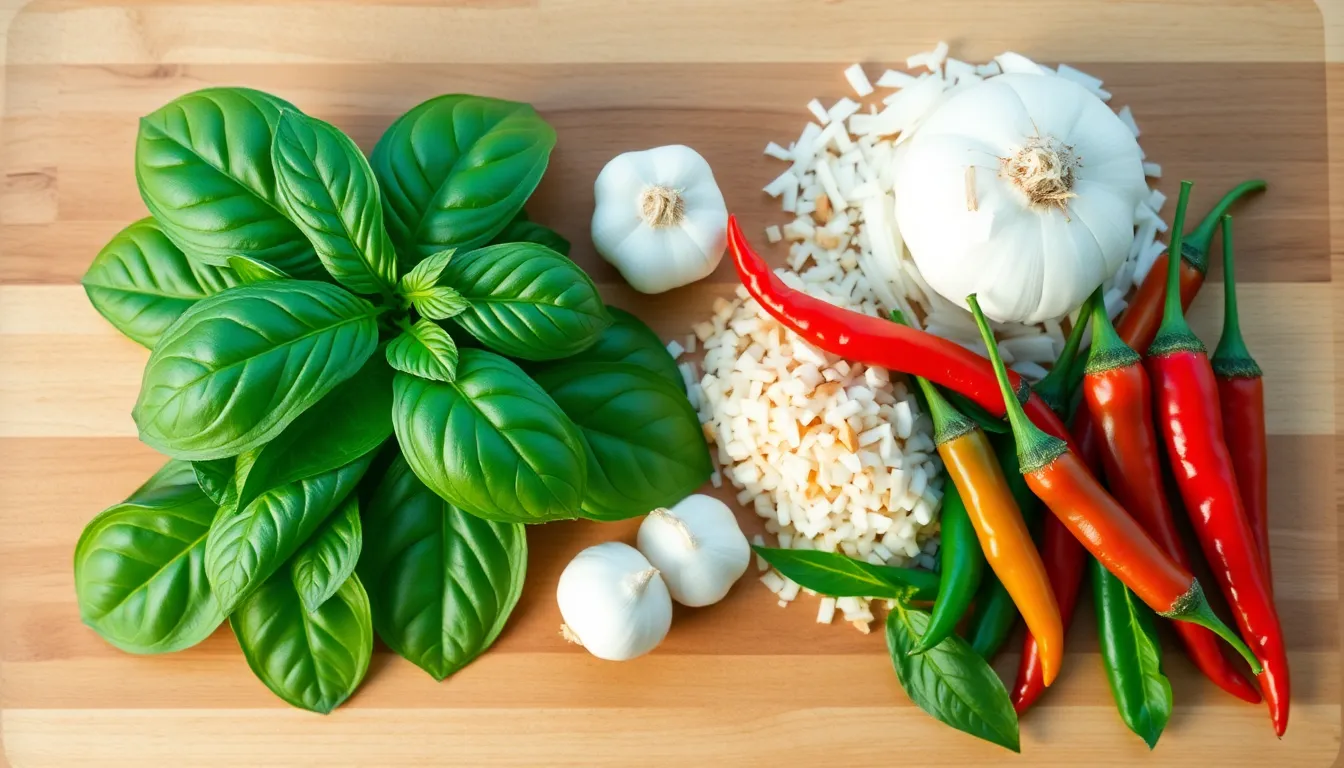
Creating authentic Thai basil sauce requires a thoughtful combination of fresh herbs, aromatic spices, and savory liquids. Each ingredient plays an essential role in achieving that perfect balance of flavors that makes this sauce so distinctively Thai.
Fresh Thai Basil Leaves
Thai basil serves as the star ingredient in this flavorful sauce, contributing its signature fragrance and distinctive taste. Unlike sweet Italian basil, Thai basil offers a mildly spicy flavor profile with pronounced licorice or anise notes that can withstand high cooking temperatures without losing its robust character. You’ll need about 1-2 cups of fresh Thai basil leaves, preferably with purple stems which indicate true Thai basil variety. Should you find yourself without access to Thai basil, Italian sweet basil makes an acceptable substitute though the flavor profile will be less spicy and more sweet. Holy basil (tulsi) can also work in a pinch, bringing a different but complementary peppery quality to your sauce.
Aromatics and Spices
The aromatic foundation of Thai basil sauce begins with several key ingredients that build layers of flavor. You’ll need 4-5 cloves of minced garlic and 2-3 tablespoons of finely chopped shallots or onions which get sautéed until fragrant to create a savory base. Heat comes from Thai bird’s eye chilies or jalapeños – use 2-5 depending on your spice tolerance level. Many recipes incorporate fresh ginger (about 1 tablespoon minced) especially in blended variations of the sauce, adding warmth and complexity. A pinch of black or white pepper helps deepen the spice profile without overwhelming the delicate basil flavor. These aromatics work together to create the characteristic depth that makes Thai cuisine so captivating.
Liquid Ingredients
The liquid components of Thai basil sauce provide both flavor and the right consistency while balancing the taste profile. Start with approximately ¼ cup of unsalted stock – chicken, pork, or vegetable all work well depending on your preference or dietary needs. For umami depth, add 1-2 tablespoons each of oyster sauce (vegetarian versions available), soy sauce, and fish sauce. Vegans can substitute the fish sauce with additional soy sauce or tamari. Balance these savory elements with 1-2 teaspoons of sugar or palm sugar which rounds out the flavor profile without making the sauce overtly sweet. A splash of rice wine vinegar or rice wine (about 1 tablespoon) introduces brightness and acidity that cuts through the richness of the other ingredients. These liquid components merge to create the perfect consistency that clings beautifully to your chosen proteins or vegetables.
Equipment Needed
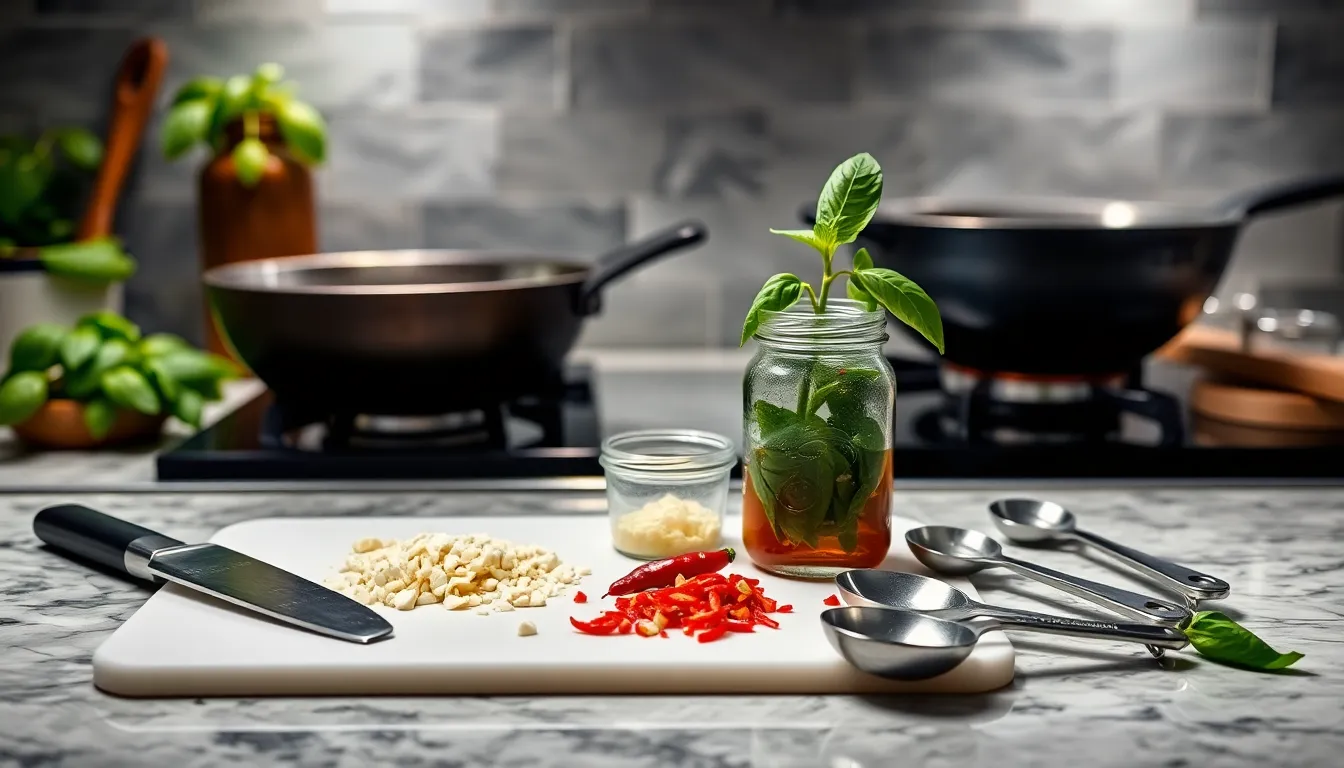
Creating Thai basil sauce requires minimal equipment yet each tool plays a crucial role in developing the distinctive flavors of this aromatic condiment. Your kitchen likely already contains everything needed to whip up this versatile sauce.
A wok or large skillet serves as the primary cooking vessel where magic happens. The high sides and excellent heat distribution make it ideal for quickly sautéing aromatics without burning them. If you don’t own a wok a regular frying pan works perfectly fine though you might need to cook in smaller batches.
You’ll need a sharp chef’s knife and cutting board to precisely mince garlic finely chop chilies and slice shallots. The knife quality matters when working with fresh herbs as a dull blade can bruise delicate Thai basil leaves reducing their aromatic impact.
A set of measuring spoons and cups ensures accuracy when adding liquid ingredients like fish sauce soy sauce and stock. Precision matters particularly with potent ingredients such as fish sauce where a small measurement difference can significantly alter the final flavor profile.
Keep a wooden spoon or heat-resistant spatula handy for stirring the sauce as it simmers. These tools prevent scratching your cookware while allowing you to gently fold in the Thai basil leaves without crushing them.
A small bowl or container will be useful for mixing sauce ingredients before adding them to the pan. This preparation step called “mise en place” by professional chefs streamlines the cooking process making it more efficient.
For those planning to store leftover sauce a glass jar with airtight lid preserves freshness and prevents refrigerator odors from affecting the delicate balance of flavors. Glass containers won’t absorb the sauce’s aromatic compounds unlike plastic alternatives.
How to Make Thai Basil Sauce
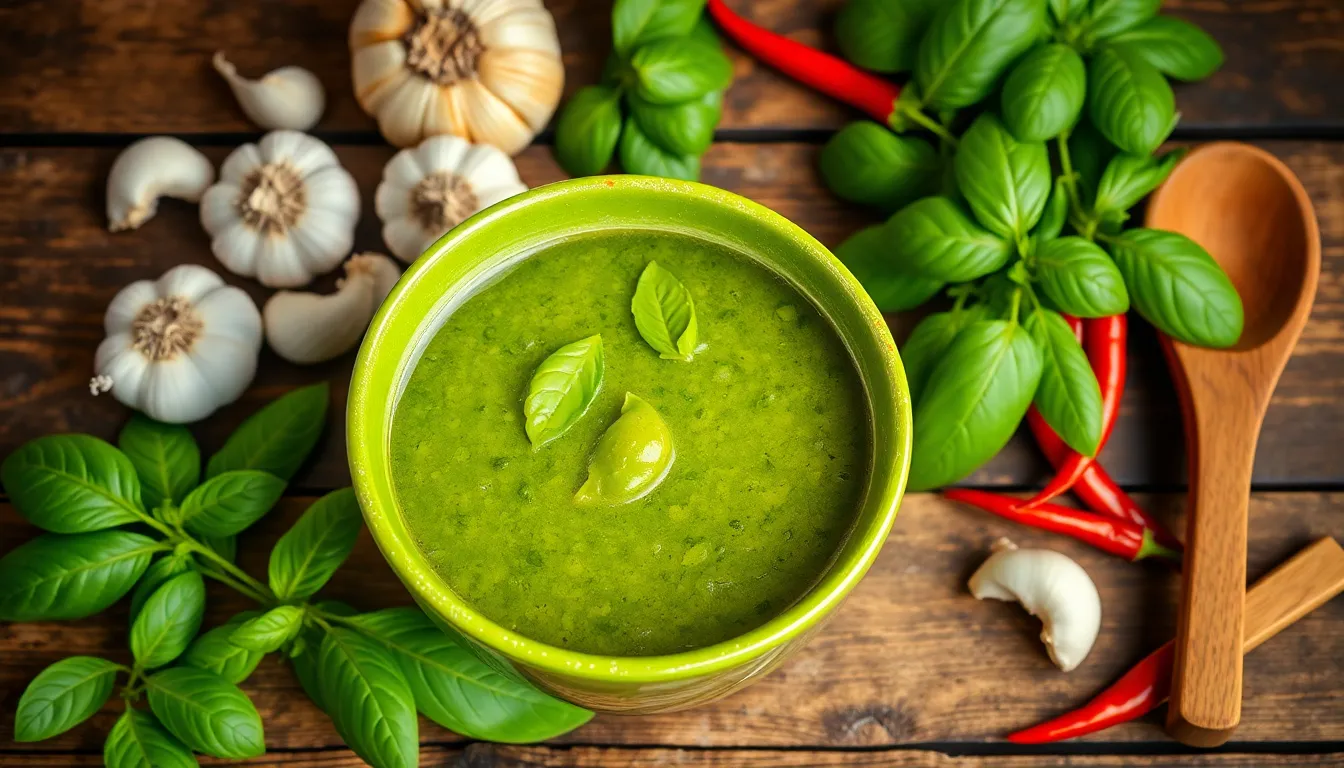
Creating authentic Thai basil sauce is simpler than you might think. Follow these steps to prepare this versatile sauce that balances sweet, savory, spicy, and herbal notes perfectly.
Preparing the Ingredients
Start by gathering fresh Thai basil leaves as your primary herb – aim for about 2 cups of leaves. If Thai basil is unavailable, substitute with holy basil or sweet Italian basil, though the flavor profile will vary slightly. Add fresh mint leaves for an extra layer of freshness. Peel and roughly chop 4-5 garlic cloves and half an onion for the aromatic base. Select your chilies based on heat preference – bird’s eye chilies provide authentic heat while jalapeños offer a milder option. Measure out your liquid ingredients: 2 tablespoons fish sauce (or soy sauce/tamari for vegetarian versions), 1 tablespoon oyster sauce, 1 tablespoon soy sauce, 1 teaspoon sugar, and 2 teaspoons rice wine vinegar. For added texture, consider chopping red bell peppers or mushrooms to incorporate later.
Blending the Sauce
For a raw blended version, place your Thai basil leaves, mint, garlic, and chilies in a food processor or blender. Add the sugar and rice wine vinegar to balance flavors. Pour in the fish sauce, oyster sauce, and soy sauce. Pulse until you achieve a smooth consistency with small flecks of herbs still visible. If the mixture seems too thick, add a tablespoon of olive or vegetable oil to thin it. Alternatively, create a cooked version by heating a tablespoon of oil in a pan over medium heat. Sauté onions until translucent (about 3 minutes), then add garlic and chilies, cooking until fragrant. Pour in ¼ cup of stock (chicken, pork, or vegetable), followed by your sauce ingredients. Let this simmer for 1-2 minutes before adding vegetables if desired. Remove from heat and stir in fresh basil leaves, allowing them to wilt naturally in the residual heat.
Adjusting the Flavors
Taste your sauce and make necessary adjustments based on your preference. Add more sugar if the sauce tastes too sharp – start with ½ teaspoon increments. Balance saltiness with additional fish sauce or soy sauce in small amounts (¼ teaspoon at a time). Control the heat level by adding more chilies for increased spiciness or a touch of lime juice to temper excessive heat. For a deeper color and richer flavor, incorporate a small splash of dark soy sauce. The final sauce should deliver a harmonious blend of sweet, savory, and spicy notes with the distinctive aroma of Thai basil. Use immediately as a stir-fry base, marinade, or dipping sauce, or store in an airtight container in the refrigerator for up to a week. For longer storage, freeze portions in ice cube trays for convenient use in future meals.
Ways to Use Thai Basil Sauce
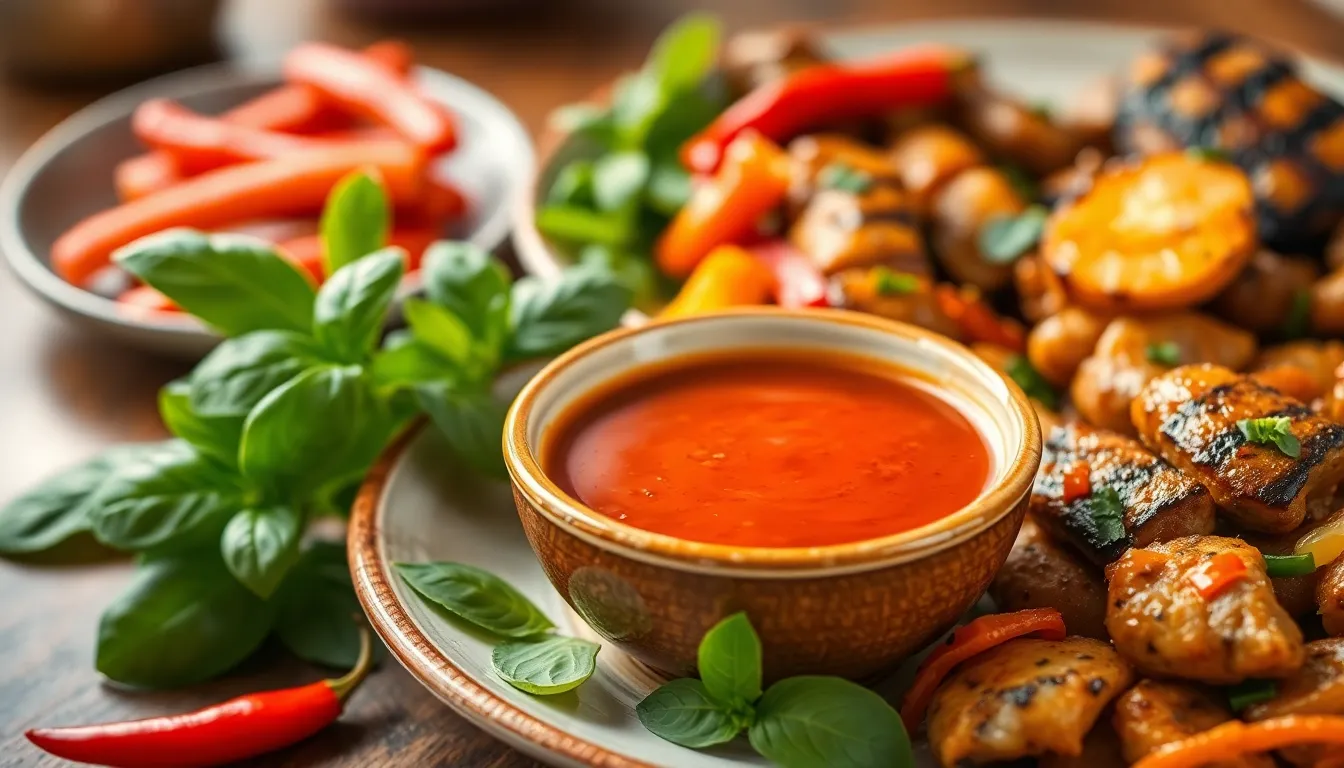
Thai basil sauce transforms ordinary dishes into extraordinary meals with its complex flavor profile and versatility. This aromatic sauce can elevate many dishes in multiple ways beyond just being a condiment.
As a Stir-Fry Sauce
Transform your weeknight dinner with Thai basil sauce as the star of your stir-fry dishes. Pad Krapow Gai (Thai Basil Chicken) showcases this sauce perfectly, where it coats tender chicken pieces and crisp vegetables with layers of flavor. Simply heat your wok until smoking, add your protein of choice, then pour in the Thai basil sauce to create an instant flavor base. The sauce ingredients—oyster sauce, soy sauce, fish sauce, sugar, garlic, and chilies—work together to create a rich, spicy, and slightly sweet coating. Add fresh basil leaves at the final moment of cooking to maintain their vibrant color and aromatic qualities. Serve your stir-fry over jasmine rice to absorb all the delicious sauce for a complete meal ready in under 20 minutes.
As a Marinade
Elevate your grilled meats by using Thai basil sauce as a flavorful marinade. The combination of oyster sauce, soy sauce, fish sauce, and sugar in the base helps tenderize proteins while infusing them with deep umami notes. Pour the sauce over chicken thighs, pork slices, beef strips, or seafood and allow them to marinate for at least 30 minutes (though overnight works best for maximum flavor penetration). The acid components break down tough protein fibers while the aromatics and basil infuse the meat with their distinctive herbal character. This preparation method results in juicy, flavor-packed proteins that taste incredible when grilled or pan-fried, developing beautiful caramelization from the sugar content in the sauce.
As a Dipping Sauce
Create an irresistible accompaniment for appetizers and snacks by serving Thai basil sauce as a dipping option. The sauce pairs beautifully with spring rolls, fried tofu, grilled satay skewers, and tempura vegetables. For the perfect dipping consistency, adjust the sauce with additional lime juice for tanginess, a splash of water to thin it out, or extra chili for heat according to your preference. The complex flavor profile—balancing sweet, savory, spicy, and herbal notes—cuts through rich fried foods and complements the smoky char of grilled items. Keep a small bowl of this sauce at the table during your next gathering and watch as guests repeatedly return for another dip, drawn in by its aromatic appeal and bold taste that enhances everything it touches.
Storing Thai Basil Sauce

Proper storage of your homemade Thai basil sauce ensures you can enjoy its vibrant flavors whenever the craving strikes. With the right techniques, you can preserve its aromatic qualities and bold taste profile for both short-term and long-term use.
Refrigeration Tips
Store your freshly made Thai basil sauce in an airtight container in the refrigerator for up to one week. The sealed container prevents the sauce from absorbing other food odors while maintaining its distinctive aroma and flavor profile. When you’re ready to use the refrigerated sauce, gently warm it to release those fragrant Thai basil notes before adding it to your dishes.
For the sauce ingredients, you can extend the life of your fresh Thai basil before making the sauce by rinsing the roots and placing the stems in a glass with about one-third full of water. Cover the basil loosely and refrigerate it—this method can keep your basil fresh for up to two weeks without changing the water, ensuring you always have the primary ingredient ready for a fresh batch of sauce.
Freezing Options
Thai basil sauce freezes exceptionally well, unlike fresh Thai basil leaves which tend to lose their flavor and texture when frozen alone. Pour your sauce into ice cube trays for convenient portion control—once frozen solid, transfer these flavor-packed cubes into freezer-safe bags or containers for easy access.
Another effective freezing method involves filling small 4 oz jars with sauce, leaving ¼ inch of headspace, then adding a thin layer of olive oil on top before sealing. The oil creates a protective barrier against air exposure, helping your sauce maintain quality for 8 to 12 months in the freezer.
When you need to use your frozen sauce, simply thaw the desired amount and incorporate it directly into stir-fries, use as a marinade, or warm it as a dipping sauce. The freezing process actually allows the complex flavors to meld together, sometimes resulting in an even more harmonious taste profile than freshly made sauce.
Variations of Thai Basil Sauce

The beauty of Thai basil sauce lies in its adaptability to different taste preferences and dietary needs. You can easily modify this versatile sauce to create distinct flavor profiles while maintaining its authentic Thai character.
Spicy Thai Basil Sauce
For heat enthusiasts, the spicy variation of Thai basil sauce delivers an intense kick that elevates any dish. Double the amount of Thai bird’s eye chilies in your base recipe to create a sauce with serious heat. You might also incorporate serrano or jalapeño peppers as alternatives when Thai chilies aren’t available. The key to balancing this fiery version lies in maintaining proper proportions of sugar and lime juice to counteract the increased spice level. This variation works exceptionally well in traditional dishes like Pad Krapow Gai (spicy Thai basil chicken), where the heat complements the aromatic qualities of the basil. Adding a splash of chili oil at the end introduces another dimension of spiciness that lingers pleasantly on the palate.
Creamy Thai Basil Sauce
Transform the traditional sauce into a luxurious creamy version by incorporating coconut milk or cream. This variation mellows the heat while adding richness and body to the sauce. Start with your standard Thai basil sauce recipe, then stir in 1/4 to 1/2 cup of coconut milk, adjusting to reach your desired consistency. The creamy component pairs beautifully with the aromatic licorice notes of Thai basil. This adaptation works wonderfully with grilled seafood, particularly salmon or shrimp. For a fusion approach, blend fresh Thai basil leaves with garlic, chili, and olive oil to create a paste, then mix with cream for a Thai-Italian hybrid sauce that coats pasta perfectly. The cooling effect of the creamy ingredients makes this version more approachable for those sensitive to spice while still delivering authentic Thai flavors.
Vegan Thai Basil Sauce
Creating a plant-based version of this classic sauce requires simple substitutions that maintain its complex flavor profile. Replace fish sauce with soy sauce or tamari for that essential umami element. Vegetarian oyster sauce (often made from mushrooms) serves as an excellent stand-in for traditional oyster sauce. The rest of the ingredients—Thai basil, garlic, chilies, and palm sugar—remain the same, ensuring authentic taste without animal products. This vegan adaptation preserves the aromatic, spicy characteristics that make Thai basil sauce so beloved. Try adding a teaspoon of miso paste to enhance the depth of flavor, compensating for the absence of fish sauce. This version works beautifully in vegetable stir-fries with tofu or as a flavorful addition to plant-based noodle dishes. The sauce keeps well in the refrigerator, allowing the flavors to meld and develop over several days.
Nutritional Benefits of Thai Basil Sauce
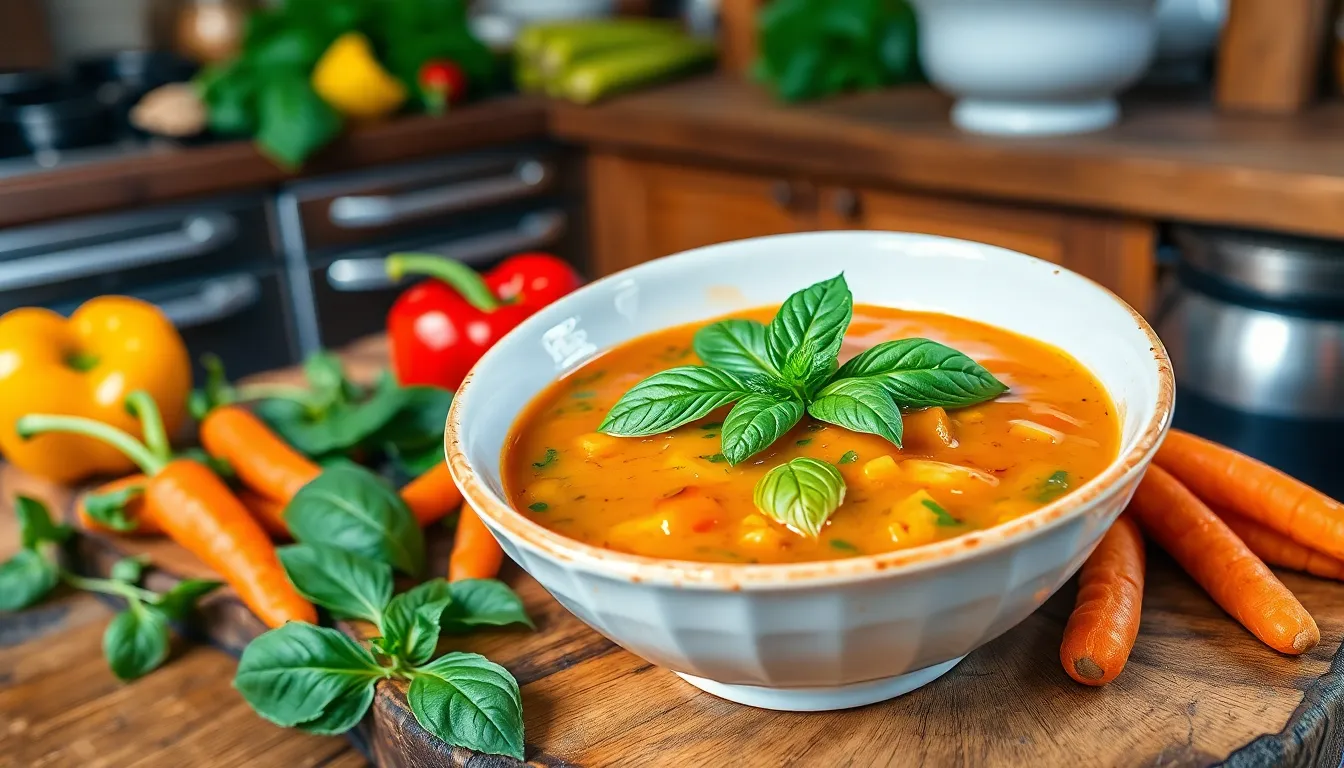
Key Nutrients from Thai Basil
Thai sweet basil forms the foundation of this flavorful sauce and delivers impressive nutritional benefits even though being used in small quantities. This aromatic herb contains essential vitamins A K and C which support your immune system and promote overall health. Fresh Thai basil is particularly rich in vitamin K providing between 13% to 43% of your recommended daily intake depending on whether you use fresh or dried varieties. Beyond vitamins Thai basil contains powerful plant compounds with antioxidant and anti-inflammatory properties that contribute to long-term health benefits.
Macronutrient Profile of Thai Basil Sauce
The typical Thai basil stir fry sauce offers a light nutritional footprint with approximately 10 calories per tablespoon (16 grams). Its macronutrient composition breaks down to roughly 47% carbohydrates and 53% fat with minimal protein content. Each tablespoon contains about 0.5g of fats primarily healthy unsaturated varieties and a moderate 40mg of sodium. This makes the sauce a relatively light addition to your meals without significantly impacting your daily caloric intake.
| Nutrient | Amount per Tablespoon (16g) | % Daily Value |
|---|---|---|
| Calories | 10 | – |
| Fat | 0.5g | <1% |
| Sodium | 40mg | 2% |
| Carbs | 1.2g | <1% |
| Protein | <0.5g | <1% |
| Vitamin K | Varies | 13-43% |
Minerals and Vitamins in the Sauce
Thai basil sauce provides trace amounts of important minerals including calcium (2mg per tablespoon) and potassium (8mg per tablespoon). While these quantities represent small contributions to your daily requirements they add incremental nutritional value to your meals. The vitamin content of the sauce derives primarily from the Thai basil itself though the actual amounts vary based on the recipe preparation method and quantity used.
Health-Related Attributes
The antioxidants found in Thai basil help combat oxidative stress in your body while its anti-inflammatory compounds may reduce inflammation. Vitamin K plays a crucial role in blood clotting functions while vitamins A and C support immune health and overall wellbeing. The sauce’s low calorie and moderate fat profile makes it an excellent choice for adding bold flavor without compromising nutritional goals. This combination of taste and health benefits positions Thai basil sauce as a smart addition to a balanced diet.
Thai basil sauce delivers its most important nutritional benefits through the concentrated plant compounds in its star ingredient. The sauce enhances meals with minimal caloric impact while providing subtle nutritional advantages that complement its bold flavor profile.
Perfect Pairings for Thai Basil Sauce
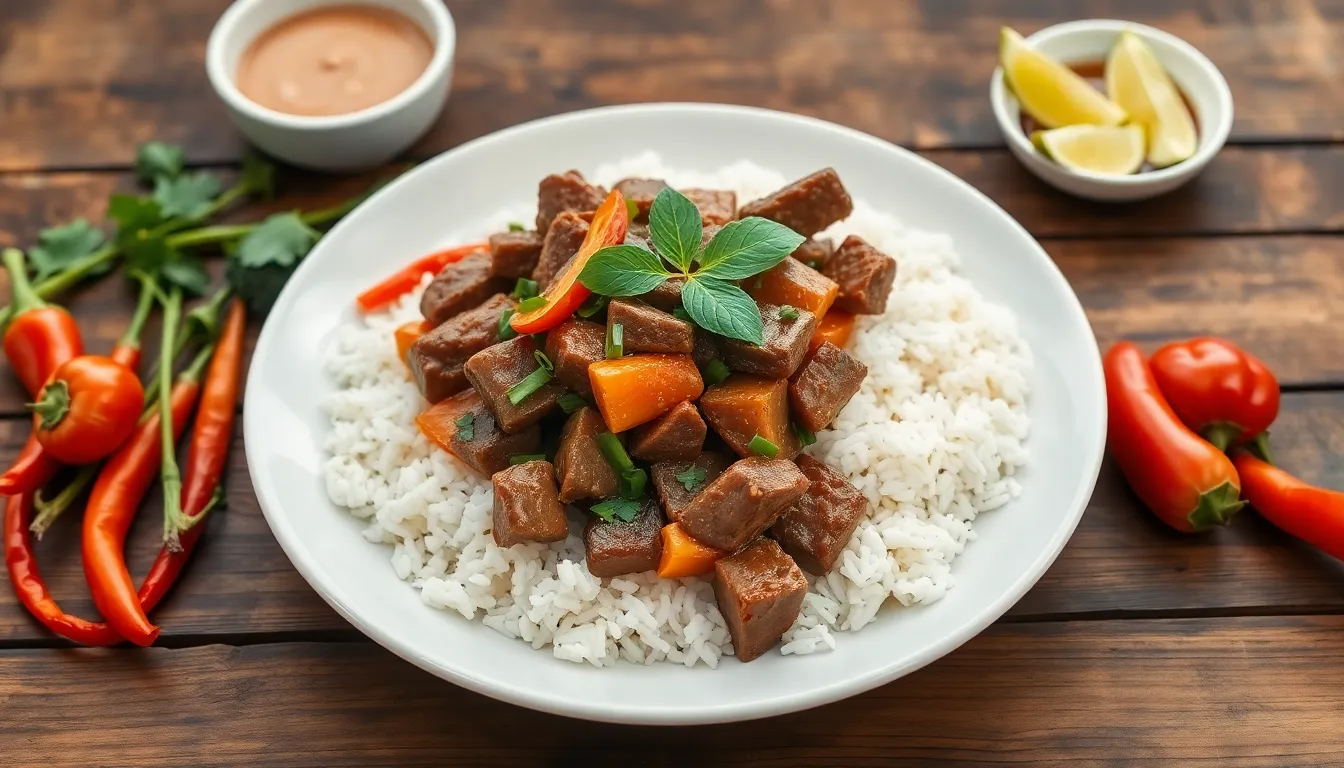
Thai basil sauce brings vibrant flavor to a wide range of dishes with its perfect balance of sweet, savory, spicy, and aromatic elements. Discover the most complementary pairings that showcase this versatile sauce at its best.
Protein Companions
Thai basil sauce transforms ordinary proteins into extraordinary meals. Chicken creates the classic Pad Krapow Gai when stir-fried with this aromatic sauce, delivering an authentic Thai street food experience. Ground beef or pork works beautifully as both stir-fry protein and filling for Thai basil beef rolls, absorbing the complex flavors while adding rich texture. Seafood options like shrimp and firm white fish benefit from the sauce’s aromatic profile without being overwhelmed.
Vegetarians can enjoy equally satisfying results with tofu or tempeh, which readily soak up the vibrant flavors. For plant-based versions, simply substitute traditional fish sauce with soy sauce and use vegetarian oyster sauce alternatives to maintain the authentic taste profile.
Vegetable Combinations
Fresh vegetables provide the perfect canvas for Thai basil sauce. Bell peppers contribute sweet crunch while absorbing the sauce’s aromatic qualities. Asparagus spears maintain their distinct texture while being enhanced by the sauce’s umami depth. Broccoli florets capture the sauce perfectly in their tree-like structure, creating flavor-packed bites.
Mixed greens wilt slightly when tossed with warm Thai basil sauce, creating a warm salad with intense flavor. The sauce also elevates dumpling fillings with its punchy character, adding depth to otherwise simple vegetable combinations. Try drizzling it over deep-fried vegetables for an instant flavor upgrade that balances the richness of the cooking method.
Rice and Noodle Pairings
Steamed jasmine rice serves as the traditional foundation for Thai basil sauce dishes, its subtle floral aroma and fluffy texture balancing the sauce’s bold flavors. Thai basil sauce transforms ordinary fried rice into fragrant Basil Fried Rice, a one-dish meal bursting with aromatic intensity.
Wide rice noodles become the famous Drunken Noodles (Pad Kee Mao) when tossed with Thai basil sauce, creating a satisfying main dish with complex flavor. Even simple vermicelli noodles gain character when dressed with this versatile sauce, making quick weeknight meals taste like they took hours to prepare.
Complementary Dipping Sauces
Enhance dishes featuring Thai basil sauce with complementary dipping options. Satay-style peanut sauce provides creamy richness that contrasts beautifully with the herbal notes in Thai basil beef rolls. Sweet chili sauce contributes additional layers of sweetness and heat that amplify the existing flavor profile.
Cucumber relish offers cool crunch against the warm spice of Thai basil dishes, creating textural contrast and temperature balance. Lime wedges served alongside provide fresh acidity that brightens the entire flavor profile, allowing diners to adjust the tang to their preference.
| Pairing Category | Best Options | Flavor Contribution |
|---|---|---|
| Proteins | Chicken, ground meat, tofu | Rich base for sauce absorption |
| Vegetables | Bell peppers, broccoli, asparagus | Texture and freshness |
| Carbohydrates | Jasmine rice, wide rice noodles | Neutral base that balances heat |
| Dipping Sauces | Peanut sauce, sweet chili sauce | Complementary flavor dimensions |
Troubleshooting Tips
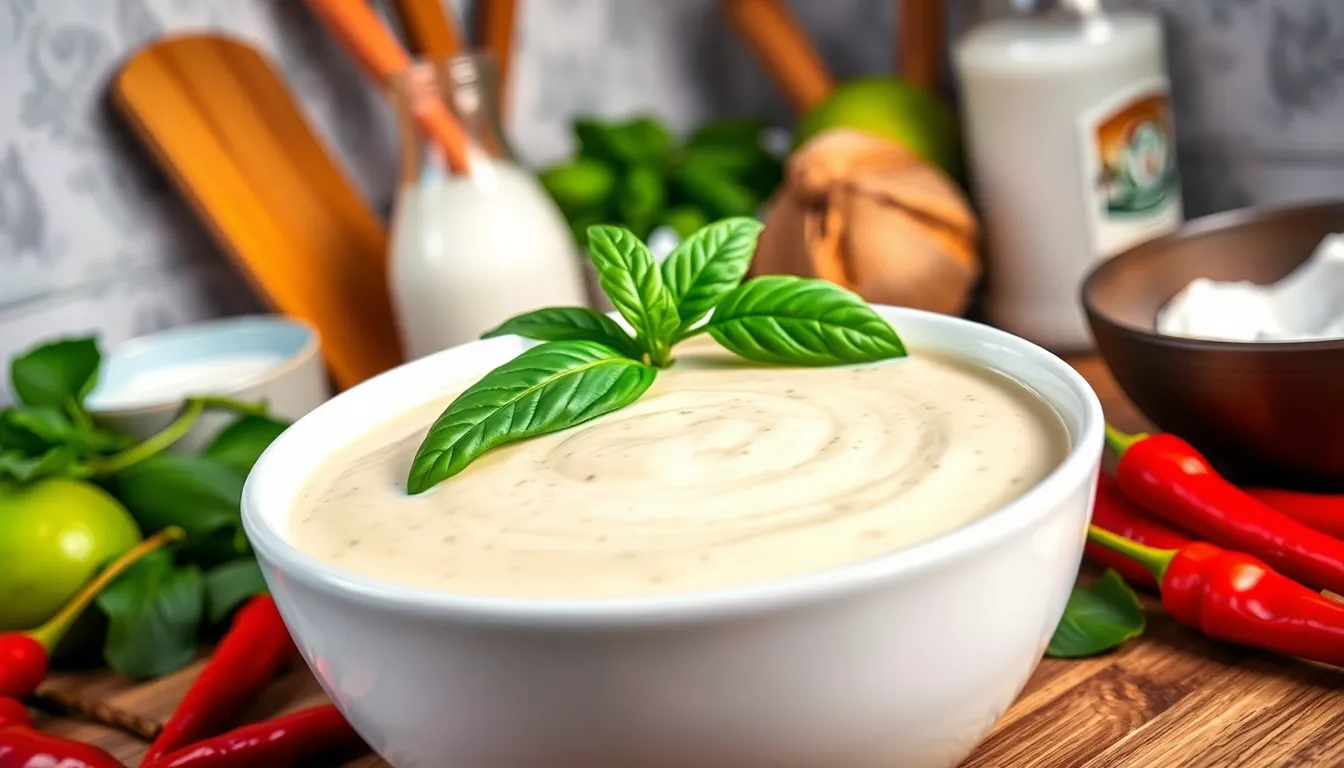
Sauce Is Too Spicy
Accidentally added too many Thai chilies? Balance the heat by stirring in additional coconut milk or a touch of honey. Adding more basil leaves can also help temper the spiciness while improving the herbaceous flavor profile. For immediate heat reduction try serving the sauce with cooling elements like cucumber slices or plain jasmine rice.
Sauce Is Too Thin
If your Thai basil sauce lacks the desired consistency create a quick cornstarch slurry by mixing 1 teaspoon cornstarch with 1 tablespoon cold water. Add this mixture to your simmering sauce and stir until it thickens. Alternatively let the sauce reduce over low heat for 3-5 minutes stirring occasionally to concentrate flavors and evaporate excess liquid.
Sauce Is Too Salty
Excessive fish sauce or soy sauce can overwhelm your Thai basil sauce. Remedy this by adding a squeeze of fresh lime juice which cuts through saltiness while brightening flavors. A small amount of palm sugar or brown sugar also helps counteract saltiness. Diluting with additional stock or water can restore balance without sacrificing flavor intensity.
Basil Turning Black
Fresh basil leaves can quickly discolor when exposed to high heat for too long. Preserve their vibrant green color by adding them at the very end of cooking and removing the pan from heat immediately. Stir just until the leaves wilt slightly. For make-ahead sauce prepare everything except the basil then add fresh leaves just before serving.
Flavors Seem Flat
When your sauce lacks depth incorporate umami-rich ingredients like a splash of dark soy sauce or a pinch of mushroom powder. Toasted ground coriander seeds (1/4 teaspoon) can add complexity without overpowering the basil. Fresh lime zest brightens dull flavors while a drizzle of sesame oil adds aromatic richness.
Sauce Separates When Stored
Oil separation in stored Thai basil sauce is normal. Simply shake or stir before using. For sauces with coconut milk that separate during refrigeration gently warm and whisk to recombine. Freezing in individual portions minimizes separation issues and preserves flavor integrity for longer storage periods.
Substitution Failures
When substituting Italian basil for Thai basil increase the quantity by 25% and add a pinch of ground star anise to approximate Thai basil’s licorice notes. Vegan versions falling flat often need additional umami which fermented black bean sauce or mushroom-based soy sauce can provide. Lacking Thai chilies substitute serrano peppers but reduce the quantity by half to maintain balanced heat.
The Best Thai Basil Sauce Recipe
Thai basil sauce truly stands as a kitchen superhero that can transform any ordinary meal into something extraordinary. With its perfect balance of sweet savory spicy and herbal notes you’ll find endless ways to incorporate this versatile condiment into your cooking routine.
Whether you’re drizzling it over grilled chicken folding it into a stir-fry or using it as a dipping sauce for spring rolls this aromatic blend brings authentic Thai flavors to your table with minimal effort.
Make a batch today and discover how this simple sauce can elevate your meals throughout the week. Your taste buds will thank you for introducing them to the bold distinctive flavors that make Thai cuisine so beloved worldwide.
Frequently Asked Questions
What makes Thai basil sauce different from other sauces?
Thai basil sauce stands out with its unique combination of Thai basil (with purple stems and anise-licorice notes), garlic, chilies, and fish sauce. Unlike Italian basil-based sauces, Thai basil maintains its robust flavor even under high heat. The sauce achieves a perfect balance of five taste elements: spicy, sweet, sour, salty, and umami, creating a depth that enhances dishes without overwhelming them.
How long can I store homemade Thai basil sauce?
Homemade Thai basil sauce can be stored in an airtight container in the refrigerator for up to one week. For longer storage, freeze the sauce in ice cube trays or small jars for up to three months. Freezing can actually enhance the sauce’s flavor profile. Always ensure containers are sealed properly to maintain freshness and aromatic qualities.
Can I make Thai basil sauce vegetarian or vegan?
Yes! Create a plant-based version by substituting fish sauce with soy sauce or tamari, and using vegetarian oyster sauce (made from mushrooms). These alternatives ensure the sauce maintains its authentic Thai character while being suitable for vegetarian and vegan diets. The resulting sauce still offers the same complex flavor profile and versatility for various dishes.
What are the best dishes to use Thai basil sauce with?
Thai basil sauce is incredibly versatile. Use it as a stir-fry sauce for dishes like Pad Krapow Gai (Thai Basil Chicken), as a marinade for grilled meats, or as a dipping sauce for spring rolls and fried tofu. It pairs beautifully with chicken, ground meats, tofu, bell peppers, broccoli, jasmine rice, and wide rice noodles. The sauce transforms ordinary meals into extraordinary culinary experiences.
What equipment do I need to make Thai basil sauce?
You need minimal equipment: a wok or large skillet for sautéing aromatics, a sharp chef’s knife and cutting board for ingredient prep, measuring spoons and cups for accuracy with potent ingredients, a wooden spoon or heat-resistant spatula for stirring, and a glass jar with an airtight lid for storage. For the raw version, a food processor is helpful.
What are the nutritional benefits of Thai basil sauce?
Thai basil sauce is nutritionally light with approximately 10 calories per tablespoon. Thai basil contains vitamins A, K, and C, supporting immune health. The sauce provides antioxidants that combat oxidative stress and reduce inflammation. With a macronutrient profile of 47% carbohydrates and 53% fat, it enhances meals with minimal caloric impact while offering subtle nutritional advantages.
How can I fix my Thai basil sauce if it’s too spicy?
If your sauce is too spicy, add coconut milk or a touch of honey/palm sugar to balance the heat. For thin consistency, incorporate a cornstarch slurry to thicken it. If it’s too salty, add lime juice or a bit more sweetener. To preserve the vibrant green color, blanch basil leaves briefly before adding them to the sauce.
Can I use regular basil instead of Thai basil?
While you can substitute regular (Italian) basil in a pinch, the flavor profile will be noticeably different. Thai basil has a distinctive anise-licorice flavor and holds up better to heat. If using Italian basil, add a small amount of star anise or a drop of anise extract to mimic Thai basil’s unique taste. For best results, seek out Thai basil at Asian markets.
